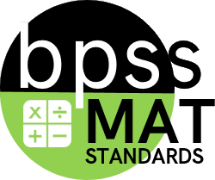MAT-02.GM.G.03

|
2nd Grade (MAT) Targeted Standard
(GM) Geometry and Measurement
(G) Geometry
Learners will compose and classify figures and shapes based on attributes and properties; represent and solve problems using a coordinate plane.
|
MAT-02.GM.G.03 Compose geometric shapes having specified geometric attributes, such as a given number of edges, angles, faces, vertices, and/or sides.*
 Proficiency Scale Proficiency Scale
Progressions
Two-Dimensional Shapes
- MAT-00.GM.G.01 Name shapes and identify them as two-dimensional (squares, circles, triangles, rectangles)regardless of their orientations or overall size.
- MAT-00.GM.G.03 Compare and classify two-dimensional shapes to describe their similarities, differences, and attributes (squares, circles, triangles, rectangles).
- MAT-01.GM.G.01 Name shapes and identify them as two-dimensional (trapezoids, rhombuses, pentagons, hexagons, octagons).
- MAT-01.GM.G.03 Determine geometric attributes of two-dimensional and three-dimensional shapes.
- MAT-02.GM.G.01 Identify two-dimensional shapes (parallelograms and quadrilaterals).
- MAT-02.GM.G.03 Compose geometric shapes having specified geometric attributes, such as a given number of edges, angles, faces, vertices, and/or sides.
- MAT-03.GM.G.01 In two-dimensional shapes, identify lines, angles (right, acute, obtuse), and perpendicular and parallel lines.
- MAT-03.GM.G.02 Sort quadrilaterals into categories based on attributes.
- MAT-04.GM.G.01 Identify, label, and draw points, lines, line segments, rays, and angles (right, acute, obtuse).
- MAT-04.GM.G.02 Classify two-dimensional figures based on the presence or absence of parallel or perpendicular lines or the presence or absence of angles of specified size.
- MAT-05.GM.G.01 Classify two-dimensional figures in a hierarchy based on properties.
- MAT-10.GM.01 Know precise definitions of angle, circle, perpendicular line, parallel line, and line segment based on the undefined notions of point, line, and plane.
- MAT-10.GM.09 Prove and apply theorems about lines and angles.
- MAT-10.GM.10 Prove and apply theorems about triangles.
- MAT-10.GM.11 Prove and apply theorems about parallelograms.
- MAT-10.GM.34 Identify the shapes of two-dimensional cross-sections of three-dimensional objects and identify three-dimensional objects generated by rotations of two-dimensional objects.
Three-Dimensional Shapes
- MAT-00.GM.G.02 Name shapes and identify them as three-dimensional (cubes and spheres) regardless of their orientations or overall size.
- MAT-01.GM.G.02 Name and identify solids as three-dimensional (cylinders, cones, triangular prisms, and rectangular prisms).
- MAT-01.GM.G.03 Determine geometric attributes of two-dimensional and three-dimensional shapes.
- MAT-02.GM.G.02 Identify two-dimensional shapes found within three-dimensional shapes.
- MAT-02.GM.G.03 Compose geometric shapes having specified geometric attributes, such as a given number of edges, angles, faces, vertices, and/or sides.
- MAT-06.GM.GF.03 Represent three-dimensional figures using nets made up of rectangles and triangles (right prisms and pyramids whose bases are triangles and rectangles). Calculate the surface area of prisms with rectangular and triangular
bases using nets, including authentic problems.
Compose Shapes
- MAT-00.GM.G.04 Compose a geometric shape by combining two or more simple shapes.
- MAT-01.GM.G.04 Compose a geometric shape or solid by combining multiple two-dimensional shapes and/or three-dimensional solids.
- MAT-02.GM.G.03 Compose shapes having specified geometric attributes, such as a given number of edges, angles, faces, vertices, and/or sides.
- MAT-07.GM.GF.01 Draw triangles from given conditions using appropriate tools. Defend whether a unique triangle, multiple triangles, or no triangle can be constructed when given three measures of angles or sides.
- MAT-10.GM.12 Make basic geometric constructions (e.g., segments, angles, bisectors, parallel and perpendicular lines) with a variety of tools and methods.
- MAT-10.GM.13 Apply basic construction to create polygons such as equilateral triangles, squares, and regular hexagons inscribed in a circle.
|

